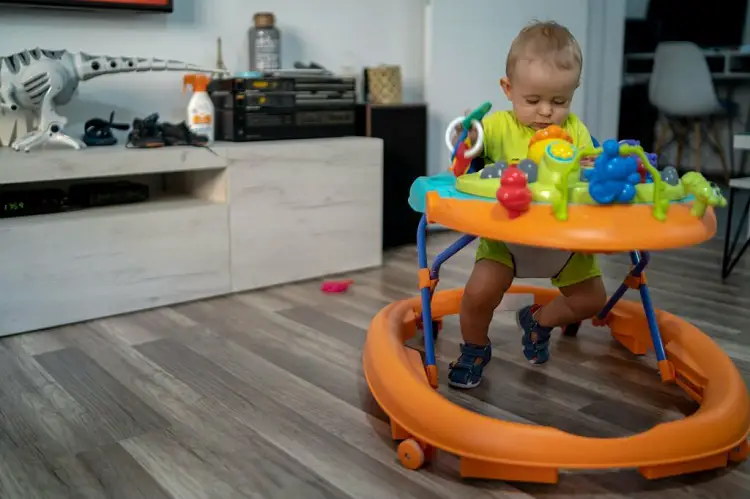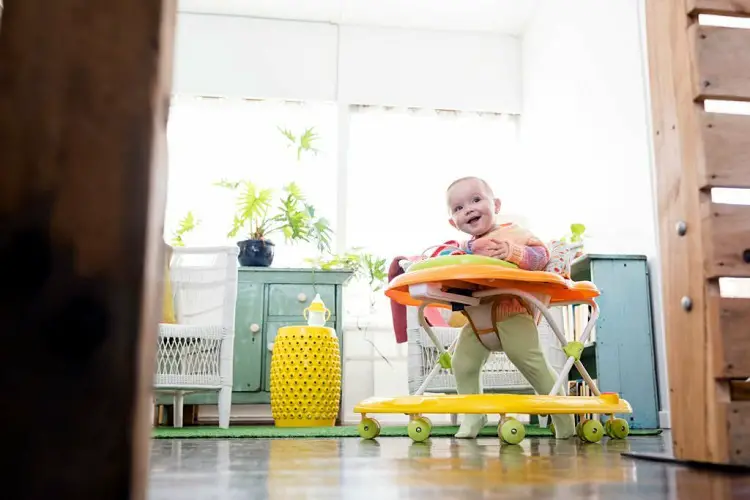Are you worried about how to fix baby walker wheels? Don’t worry, we’ve all been there before.
Baby walkers are one of the essential baby gear that provides a stimulating environment for infants learning to explore and develop their mobility.
However, like any mechanical device, baby walkers can face wheel issues that affect their performance and safety.
From misalignment to wear and tear, these challenges can hinder a smooth and secure movement for the little one.
Here we delve into the various problems that can arise with baby walker wheels and provide comprehensive steps to troubleshoot and fix these issues effectively.
By understanding how to inspect, clean, align, and replace wheels, caregivers can ensure a safe and enjoyable experience for their child while using a baby walker.
Baby Walker
Baby walkers are valuable tools that aid in a child’s developmental journey, providing a sense of independence and fostering early mobility.
These devices support infants as they take their first steps and navigate their surroundings.
However, just like any equipment, baby walkers may encounter mechanical challenges, particularly concerning their wheels.
Problems such as misalignment, worn-out parts, or obstructions can hinder the walker’s functionality and, more importantly, the safety of the child using it.
In this guide, we focus on troubleshooting and resolving common wheel-related issues in baby walkers.
By understanding how to address these concerns and maintain the walker’s wheels, parents and caregivers can ensure a safe and enjoyable experience for their little ones during this crucial stage of exploration and growth.
How To Fix Baby Walker Wheels

Fixing your baby walker wheels isn’t a big deal because you can fix it on your own provided you follow the steps.
Here is a step-by-step on how to fix baby walker wheels.
1. Check for Debris or Hair
Before using the walker, it’s essential to conduct a thorough examination of the wheels. Check for any obstructions, such as hair, thread, or debris, which can cause the wheels to jam and impede the smooth movement of the walker.
Take a closer look at the wheels and axles, and use a clean cloth or a brush to remove any accumulated dirt that can hinder the proper functioning of the walker.
If there is still hair stuck in the wheels, you can use a pair of scissors or tweezers to carefully remove it.
Be sure to check the wheels regularly and clean them as needed to prevent a build-up of hair and dirt.
Make sure to clear out any small particles that can get stuck in the nooks and crannies of the wheels and axles.
By taking the time to carefully inspect and clean the wheels, you can ensure that your walker operates smoothly and efficiently.
2. Ensure Proper Alignment
It is important to ensure the wheels of a baby walker are properly aligned to prevent wobbling or uneven movement.
To correct this, you should gently push or pull the wheels to align them with the frame of the walker.
Take the time to check if all the wheels are facing the same direction and adjust them as needed to ensure they are properly aligned with the frame. By doing so, you can ensure the baby walker moves smoothly and safely as intended.
3. Tighten Loose Screws
To ensure the safety and proper functioning of the wheels, it is essential to inspect the screws or bolts that hold the wheels in place.
Look for any loose screws or bolts and use a screwdriver or a wrench to securely tighten them.
Pay attention to the tightness of the screws and bolts and make sure they are snug but not overly tightened to avoid damaging the parts.
Taking these simple steps can help prevent accidents and prolong the lifespan of your baby wheel.
4. Check for Damaged Wheels
As part of the safety check for a baby walker, it is crucial to carefully inspect each wheel for any signs of damage, such as cracks, chips, or deformities.
Any damage to the wheels can significantly affect the stability and safety of the baby walker, ultimately putting the child at risk.
Therefore, it is essential to thoroughly examine each wheel and ensure that they are all in good condition.
In case any wheel is found to be significantly damaged, it’s highly recommended to replace it with a new one to ensure maximum safety and stability for the baby.
5. Replace Damaged Wheels
Purchase replacement wheels that match the specifications of the original wheels in terms of size, shape, and attachment mechanism.
Most baby walker wheels are designed to be easily replaceable. Follow the manufacturer’s guidelines for purchasing compatible replacement wheels.
6. Ensure Proper Wheel Size
It is crucial to verify that the replacement wheels are of the correct size and dimensions before installing them.
Measure the diameter and width of the original wheels to ensure an exact match with the replacements.
Using wheels that are not the right size could potentially impact the stability and mobility of the walker, compromising the user’s safety and comfort.
Therefore, it is highly advised to double-check the wheel specifications before making any replacements.
7. Install Replacement Wheels
To begin replacing old or damaged wheels, it is important to take caution when removing them.
Using a screwdriver or releasing any locking mechanisms that may be present, gently unscrew the wheels from their axles.
Once the old wheels have been removed, installing the new ones is time.
It’s highly recommended to follow the manufacturer’s instructions which usually include securing the wheels onto the axles and ensuring a tight fit.
This may require the use of additional tools or hardware to ensure a secure fitment. Taking the time to properly install the new wheels will ensure they are fitted and functioning correctly.
8. Test the Baby Walker
Once the replacement wheels are securely in place, thoroughly test the baby walker to ensure it moves smoothly and evenly.
Push the walker forward, backward, and sideways to confirm that all the wheels rotate freely without any resistance or irregularities.
9. Regular Maintenance
Make it a routine to periodically inspect the baby walker’s wheels for signs of wear, debris, or misalignment.
Clean the wheels and axles as needed, and promptly address any issues to maintain the walker’s functionality and safety.
By following these steps and conducting regular maintenance, you can effectively address issues with baby walker wheels and ensure a safe and smooth experience for the child using the walker.
How To Care For A Baby Walker
Caring for a baby walker involves not only ensuring its proper functioning and safety but also creating a conducive environment for your child’s learning and development.
Here’s a comprehensive guide on how to care for a baby walker:
1. Regular Cleaning
Wipe down the baby walker regularly with a damp cloth to remove any dirt, spills, or food particles.
Clean the tray and any other removable components separately using mild soap and water, ensuring they are thoroughly dry before reattaching.
2. Inspect for Wear and Tear
Routinely check the walker for signs of wear, tear, or damage, especially in areas like the seat, wheels, and frame.
If you notice any damage, promptly address the issue to prevent it from worsening and potentially endangering your child.
3. Ensure Proper Assembly
Set up the baby walker following the manufacturer’s instructions carefully to ensure it is assembled correctly and securely.
Check the tightness of screws and bolts periodically to prevent any loosening over time.
4. Adjust for Comfort
Ensure that the baby walker is adjusted to an appropriate height for your child, allowing them to comfortably reach the floor with their feet while sitting inside.
Make necessary adjustments as your child grows to maintain a proper fit.
5. Supervise Usage
Always supervise your child while they are using the baby walker to ensure their safety and prevent accidents.
Keep a close eye on them, especially near stairs, uneven surfaces, or areas with potential hazards.
6. Limit Usage Time
Avoid excessive use of the baby walker, as prolonged use can impede the natural development of your child’s walking skills.
Use the walker for short periods each day to allow for a balance of mobility and floor play.
7. Create a Safe Environment
Ensure the area where your child uses the walker is free from sharp objects, stairs, and other potential dangers.
Baby-proof the surroundings to create a safe space for your child to explore.
8. Encourage Floor Play
Alternate the baby walker with floor playtime to encourage natural motor development and muscle strength.
Provide interactive toys and activities to stimulate their senses and encourage movement.
9. Storage and Care when Not in Use
When not in use, store the baby walker in a clean, dry area to prevent dust accumulation and maintain its cleanliness.
Avoid exposing the walker to extreme temperatures or direct sunlight, as this can cause damage over time.
10. Follow Manufacturer Recommendations
Adhere to all guidelines and recommendations provided by the manufacturer for maintaining and caring for the specific model of the baby walker you own.
By following these care guidelines, you can ensure that your baby walker remains in good condition, providing a safe and enjoyable experience for your child as they embark on their journey towards independent mobility.
Related Posts:
Conclusion
Ensuring the smooth and safe functionality of a baby walker involves proper care and attention to its wheels.
When encountering issues with the baby walker wheels, a systematic approach can effectively address and resolve these concerns.
Firstly, checking for debris, ensuring proper alignment, and tightening loose screws lay the foundation for optimal performance.
If wheels are damaged, replacing them with suitable and compatible ones is crucial.
Careful installation and regular testing ensure the walker rolls smoothly and evenly.
Maintaining a proactive approach to inspecting and cleaning the wheels, alongside adhering to manufacturer recommendations, prolongs the walker’s life and guarantees a secure and enjoyable experience for the child.
By following these steps, parents and caregivers can enhance the baby walker’s functionality, promoting a safe and supportive environment for a child’s early mobility and exploration.
